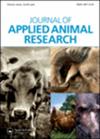红外热像仪监测昼夜节律、品种、泌乳阶段、产奶量和产次对泌乳奶牛体乳表面温度的影响
IF 1.9
4区 农林科学
Q3 AGRICULTURE, DAIRY & ANIMAL SCIENCE
引用次数: 1
摘要
本文章由计算机程序翻译,如有差异,请以英文原文为准。
Influence of circadian rhythm, breed, stage of lactation, milk yield and parity on body and udder skin surface temperature of lactating cows monitored by infrared thermography
ABSTRACT The objective of the study was to establish baseline thermographic information on body and udder skin surface temperature (USST) of lactating cows in different stages of lactation, milk yield, parity, breed and season. Holstein Friesian crossbred (n = 19 cows) and Deoni lactating cows (n = 14 cows) were monitored for body (i.e. eye) and USST prior to milking using a forward looking infra-red (FLIR) camera. It was observed that the mean body and USST of both crossbred and Deoni cows did not differ significantly. The body and USST of both the breeds were significantly higher by 0.9–1.0°C during evening than morning milking. There was no difference in body and USST between days and between udder quarters. Similarly, stage of lactation, milk yield and parity did not show any influence over body and USST. The body and USST were higher in summer (1.1°C) than in spring and winter seasons. Deoni cows had 1.0°C lesser body and USST than crossbred cows. It is concluded that baseline thermographic information on body and USST would be useful in developing breed-specific thermographic signature for individual animal.
求助全文
通过发布文献求助,成功后即可免费获取论文全文。
去求助
来源期刊

Journal of Applied Animal Research
农林科学-奶制品与动物科学
CiteScore
2.70
自引率
0.00%
发文量
80
审稿时长
6 months
期刊介绍:
Journal of Applied Animal Research (JAAR) is an international open access journal. JAAR publishes articles related to animal production and fundamental aspects of genetics, nutrition, physiology, reproduction, immunology, pathology and animal products. Papers on cows and dairy cattle, small ruminants, horses, pigs and companion animals are very welcome, as well as research involving other farm animals, aquatic and wildlife species. In addition, manuscripts involving research in other species that is directly related to animal production will be considered for publication.
 求助内容:
求助内容: 应助结果提醒方式:
应助结果提醒方式:


